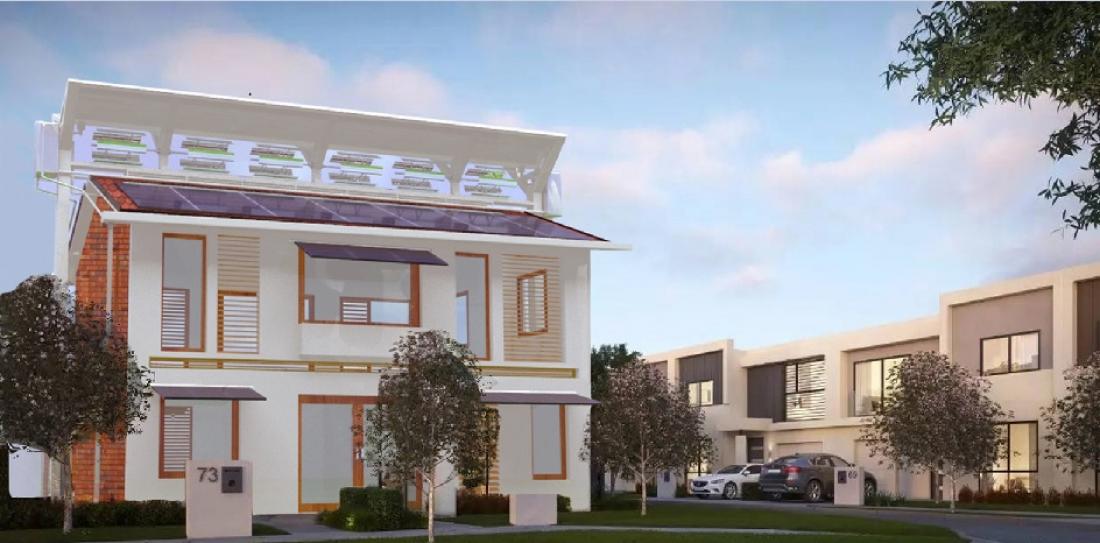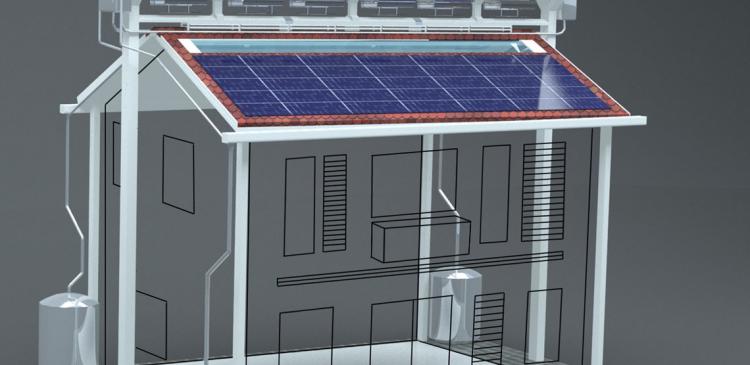The researchers say their roof could support about six people by generating more than 21,200 kWh of energy a year while saving another 1,840 kWh because of its skylights.
Scientists at the University of Malaya have designed a roof that can help address an environmental conflict: increasing demands for energy to increase living comfort versus a need to scale back fossil fuel use to address climate change. The conflict has driven interest in more efficient renewable energy sources, especially in emerging economies.
The roof’s most visible feature is a V-shaped structure set atop a peaked roof, which guides wind into a series of turbines situated below it to generate energy as they turn. The structure also increases airflow within the building by means of vents built into the peaked roof to enhance natural ventilation. In addition, a rainwater harvester is connected to an automated cooling and cleaning system that washes solar cells embedded in the sloped roof to keep them efficient. Transparent skylights brighten the main rooms inside the building during the daytime, reducing the need for artificial lighting.
The team says that adding the roof to an existing building creates minimal visual impact and can be used in urban and rural settings.
In Malaysia, the average person uses about 4,200 kilowatt hours (kWh) of energy per year. The researchers say their roof could support about six people by generating more than 21,200 kWh of energy a year while saving another 1,840 kWh because of its skylights. Also, the venting system could move about 217 million cubic metres of air and reduce carbon dioxide emissions by 17,768 kilos, while the rainwater harvester could collect close to 525 cubic metres of water.
The team says the roof’s energy yield depends on where it is located. The researchers note that there were low winds at their test location, so payback could be greater in windier areas. They say the eco-roof can be situated and adjusted for local sunlight, rainfall and wind direction, using regional weather data.
Further information
Professor Wen Tong Chong | E-mail: [email protected]
Department of Mechanical Engineering, Faculty of Engineering
University of Malaya
Meet the Expert
Dr. Chong Wen Tong graduated from the Faculty of Mechanical Engineering, UTM (Mechanical-Aeronautics) with the Best Student Award; and obtained his Ph.D. from the same university. Dr. Chong joined the Department of Mechanical Engineering, University of Malaya (UM) after spending 10 years in various industries (Dyson, LHH Precision Engineering, JK Digital Technology & Sony). He is a Chartered Engineer registered by the Engineering Council (UK). He served as the Programme Coordinator (Mechanical) in UM for about 5 years (2011-2015).
His research areas are Renewable Energy and Green Technology, and he teaches Renewable Energy at the M.Eng. level in UM. He has secured more than RM 5 million research grants, completed 9 research projects as principal investigator & 6 projects as co-researcher, and graduated 15 post-graduate candidates. Dr. Chong has filed 12 intellectual property rights and co-authored >70 ISI-indexed technical papers. He is the recipient for the University of Malaya Excellence Awards 2016 (Excellent Lecturer - Sciences & Technology). He is the Member of the Academy of Sciences Malaysia (ASM) Task Force on Carbon Free Energy, and the Member of ACCCIM 70th Science, Technology and Innovations Committee.
He has established strong collaboration with researchers from China and Taiwan, and is appointed as the Visiting Professor of Beijing Institute of Technology, Zhuhai and North China Institute of Aerospace Engineering.





